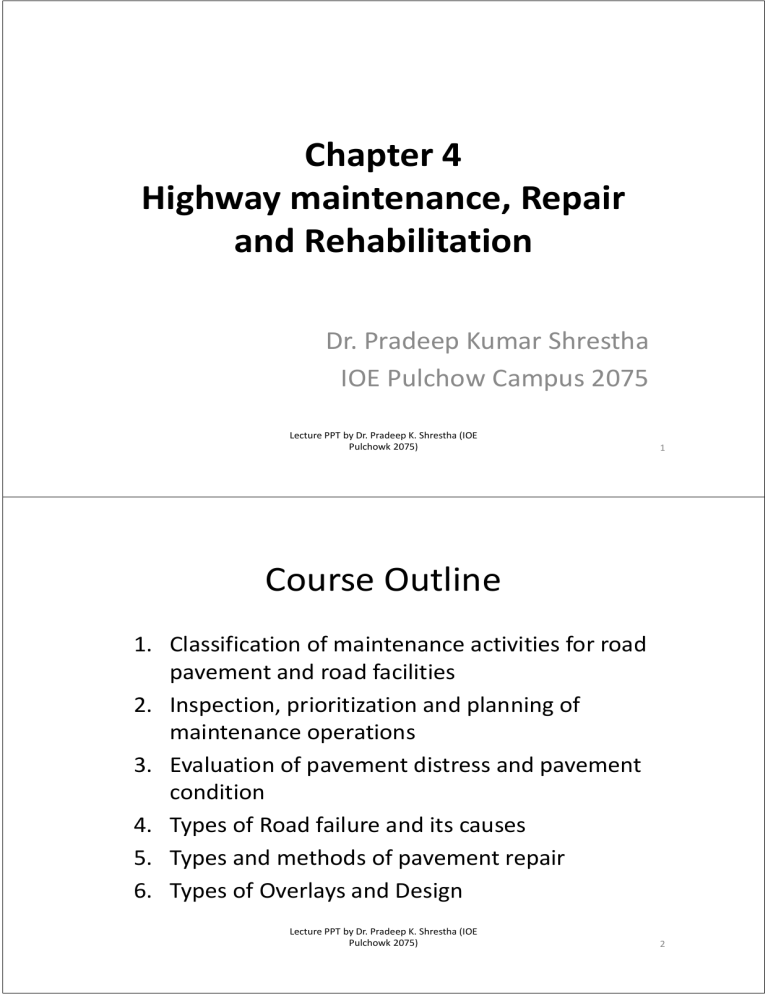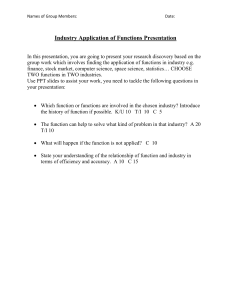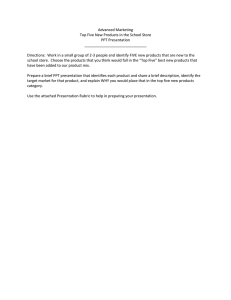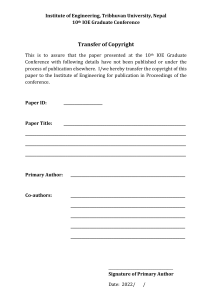
Chapter 4 Highway maintenance, Repair and Rehabilitation Dr. Pradeep Kumar Shrestha IOE Pulchow Campus 2075 Lecture PPT by Dr. Pradeep K. Shrestha (IOE Pulchowk 2075) 1 Course Outline 1. Classification of maintenance activities for road pavement and road facilities 2. Inspection, prioritization and planning of maintenance operations 3. Evaluation of pavement distress and pavement condition 4. Types of Road failure and its causes 5. Types and methods of pavement repair 6. Types of Overlays and Design Lecture PPT by Dr. Pradeep K. Shrestha (IOE Pulchowk 2075) 2 Highway Maintenance & Rehabilitation • Highway Maintenance is preserving and keeping the serviceable conditions of highway as normal as possible and as best as practicable • e.g. sealing of cracks, filling pot holes etc • Highway Rehabilitation is improving the structural strength of the pavement • e.g. overlay of greater thickness, replacement of surfacing and etc. Lecture PPT by Dr. Pradeep K. Shrestha (IOE Pulchowk 2075) 3 Concept of Pavement maintenance New (1.0) Overlay Seal Rebuild Pavement Condition V. Good (0.8) Maintenance fair (0.6) Poor (0.4) Rehabilitation Fail (0.2) Reconstruction Time Lecture PPT by Dr. Pradeep K. Shrestha (IOE Pulchowk 2075) 4 Classification of maintenance activities • Highway maintenance can be classified as: – Road Maintenance – Roadside Maintenance Lecture PPT by Dr. Pradeep K. Shrestha (IOE Pulchowk 2075) 5 Classification of maintenance activities • Road Maintenance – All maintenance works on the road way – Maintenance of all structures within road way (e.g. side ditches, culverts, causeways, bridges etc.) – Types • Routine Maintenance • Recurrent Maintenance • Periodic Maintenance PPT by Dr. Pradeep K. Shrestha (IOE • EmergencyLecture Maintenance Pulchowk 2075) 6 Routine Maintenance • Maintenance operations of localize nature • Require continually on any road regardless of its engineering characteristics or traffic volume. – Grass and bush cutting, tree pruning – Grading and reshaping of unpaved shoulders, – Clearing and cleaning of ditches and culverts, – Road sign, marking, lighting maintenance etc. – Winter maintenance (clearance of snow, ice) Lecture PPT by Dr. Pradeep K. Shrestha (IOE Pulchowk 2075) 7 Recurrent Maintenance • Maintenance operation of localized nature carried out at more or less regular interval of six months to two years with a frequency that depends on the traffic volume. • To be done by using minor equipment – Sealing cracks, – Local surface treatment, – Repair of depressions, holes and ruts, pot hole patching etc. Lecture PPT by Dr. Pradeep K. Shrestha (IOE Pulchowk 2075) 8 Periodic Maintenance • Maintenance operations of large extent required only at intervals of several years. • Frequency and type depend on the original surfacing, traffic, rainfall and climatic conditions – Resealing (surface treatment, slurry seal, thin overlay), – Re‐gravelling of unpaved road – Restoration of road marking, drainage items etc. Lecture PPT by Dr. Pradeep K. Shrestha (IOE Pulchowk 2075) 9 Emergency Maintenance • Urgent Emergency maintenance works needed for reopening of the road after slides, road wash outs etc. • Removal of debris or any other obstacles • Reinstatement of the pavement structures and drainage after rainy season • Strengthening/reconstruction of pavement • Protect road against falls of rock, flooding etc. Lecture PPT by Dr. Pradeep K. Shrestha (IOE Pulchowk 2075) 10 Classification of maintenance activities • Road side maintenance – Concerns all maintenance works on structures and surface above and below the road having direct active and / or passive influence on the road. – E.g. culverts protection works, retaining walls, cut slopes, fill slopes, unstable natural slopes, river protection works and vegetation structures. Lecture PPT by Dr. Pradeep K. Shrestha (IOE Pulchowk 2075) 11 Inspection, prioritization and planning of maintenance operations • Type and extent of maintenance depend on, – Serviceability standard – Maintenance fund available – Priorities for the maintenance operation Lecture PPT by Dr. Pradeep K. Shrestha (IOE Pulchowk 2075) 12 Inspection and Assessment of Maintenance Need • Find out road inventory (soil type, terrain, climate etc. • Nature and volume of traffic • Identify defects likely to be hazardous or cause serious inconvenience to users of the highway • Identify defects requiring urgent attention • Priorities are determined through regular inspection of each road usually the six monthly Lecture PPT by Dr. Pradeep K. Shrestha (IOE Pulchowk 2075) 13 Prioritization of maintenance operations • Urgent repairs (e.g. Removal of debris) • Routine drainage work (Ditch cleaning, cleaning of culvert bridges, filling scour areas etc.) • Routine pavement work (Grading of unpaved road, patching, sealing of paved roads) • Shoulder maintenance, grass cutting, cleaning and repairing road furniture • Periodic work like grading, re‐graveling of unpaved road, surface dressing etc. • Overlay and reconstructions Lecture PPT by Dr. Pradeep K. Shrestha (IOE Pulchowk 2075) 14 Planning of maintenance operations • Minimum acceptable service standard • Field survey for finding maintenance requirement • Factors influencing maintenance need such as sub grade, drainage, traffic, environment • Estimate extent of pavement deterioration • Development of alternatives of maintenances • Check availability of funds, material, manpower and equipment • Maintenance costs Lecture PPT by Dr. Pradeep K. Shrestha (IOE Pulchowk 2075) 15 Evaluation of Pavement Distress and Pavement condition • Assess the existing conditions and find out pavement service condition so that the maintenance and strengthening works can be planned on time • It covers a thorough study of various factors such as: » Sub grade support » Pavement composition and its thickness » Present traffic loading » Environmental conditions Lecture PPT by Dr. Pradeep K. Shrestha (IOE Pulchowk 2075) 16 Evaluation of Pavement Distress and Pavement condition • The method of pavement evaluation – Structural evaluation of pavements – Evaluation of pavement surface condition Lecture PPT by Dr. Pradeep K. Shrestha (IOE Pulchowk 2075) 17 Structural Evaluation of Pavement • May be carried out deflection at specified load • Benkelman beam is commonly used • Deflection of pavement under standard load of 8.2 ton is used to find pavement overlay thickness Lecture PPT by Dr. Pradeep K. Shrestha (IOE Pulchowk 2075) 18 Evaluation of pavement surface • Pavement may be evaluated by the surface unevenness, ruts, patches and cracks or faulty joints • AASHTO has used present serviceability index to evaluate the pavement • Surface Distress Index (SDI) which involve visual inspection of the characteristics of pavement damage • The percentages of area with cracking, potholes, deformation, patchwork, edge damage are studied Lecture PPT by Dr. Pradeep K. Shrestha (IOE Pulchowk 2075) 19 Types of Road failure and its causes 1. Failures in flexible pavements 2. Failures in Rigid pavements Lecture PPT by Dr. Pradeep K. Shrestha (IOE Pulchowk 2075) 20 Failures in Flexible Pavements Flexible pavement failures are defined by: • Excessive deformation/settlements of any layer • Excessive undulation or waves and corrugation • Lateral shoving of the pavement near the edge along the wheel path Lecture PPT by Dr. Pradeep K. Shrestha (IOE Pulchowk 2075) 21 Failures in Flexible Pavements 1. Failures of Sub Grade • Causes: – Inadequate stability or strength – Excessive stress application Lecture PPT by Dr. Pradeep K. Shrestha (IOE Pulchowk 2075) 22 Failures in Flexible Pavements 2. Failures of Sub base or Base • Causes: – Inadequate stability or strengths – Loss of binding action – Loss of base course materials – Inadequate wearing course – Use of inferior materials – Lack of lateral confinement for the granular base course Lecture PPT by Dr. Pradeep K. Shrestha (IOE Pulchowk 2075) 23 Failures in Flexible Pavements 3. Failures of Wearing course • Causes: – Improper mix design – Inadequate quality control during construction – Volatilization and oxidation of bitumen Lecture PPT by Dr. Pradeep K. Shrestha (IOE Pulchowk 2075) 24 Typical Flexible Pavement Failures a) Alligator (map) cracking: – Due to fatigue, localize weakness in base course would also cause such cracking – Because a structural failure is taking place, the only possible solution is a full‐depth patch Lecture PPT by Dr. Pradeep K. Shrestha (IOE Pulchowk 2075) 25 Typical Flexible Pavement Failures b) Rutting: – – – – Channelized depressions along the wheel‐path Due to consolidation, lateral movement of any pavement layer Insufficient pavement thickness and compaction FIX: overlay for minor, full depth removal and replacement with suitable material for severe one Lecture PPT by Dr. Pradeep K. Shrestha (IOE Pulchowk 2075) 26 Typical Flexible Pavement Failures c) Longitudinal Cracking: – Parallel to the pavements centerline – Due to frost action, differential volume change, and/or poor joint construction. – Crack < 1/2 inch can be sealed, severe cracks ‐ remove the cracked pavement layer and replace it with an overlay. Lecture PPT by Dr. Pradeep K. Shrestha (IOE Pulchowk 2075) 27 Typical Flexible Pavement Failures e) Reflection Cracking: – Observed in a flexible pavement over a rigid pavement – Occur directly over the underlying rigid pavement joints or over cracks in rigid pavement. – crack sealing for cracks less than 1/2 inch, and removal of the cracked pavement layer followed by an overlay for sever one Lecture PPT by Dr. Pradeep K. Shrestha (IOE Pulchowk 2075) 28 Typical Flexible Pavement Failures f) Pot holes: – Small, bowl‐shaped depressions in the pavement surface that penetrate up to the base course – Due to moisture infiltration and usually the end result of untreated alligator cracking – Full depth replacement patch Lecture PPT by Dr. Pradeep K. Shrestha (IOE Pulchowk 2075) 29 Typical Flexible Pavement Failures g) Ripples (corrugations) and Wave (Shoving): – Ripples or an abrupt wave across the pavement surface. – Usually occurs at points where traffic starts and stops – Caused by excess asphalt; too much fine aggregate; rounded aggregate; too soft an asphalt; or a weak granular base. – Small distortion – patching, For large – overlay Lecture PPT by Dr. Pradeep K. Shrestha (IOE Pulchowk 2075) 30 Typical Flexible Pavement Failures h) Slippage Cracking – slipping occurs when the surface is not bound with the underlying layers or low strength surface mix – Slowly, it forms pot holes – FIX: Removal and replacement of affected area. Lecture PPT by Dr. Pradeep K. Shrestha (IOE Pulchowk 2075) 31 Typical Flexible Pavement Failures i) Shear Failure – Excessive loads that cause a shear failure in the sub grade base course, or the surface – Characterized by upheaval of pavement followed with depressions. – FIX: Removal & replacement of affected area. Lecture PPT by Dr. Pradeep K. Shrestha (IOE Pulchowk 2075) 32 Typical Flexible Pavement Failures k) Raveling – The separation of aggregate particles in a pavement – Usually, the fine aggregate wears away first. Soon larger and larger particles are broken free – Due to loss of bond between aggregate and bitumen – FIX: small raveling – patching, for large raveled area a thin hot‐mix overlay Lecture PPT by Dr. Pradeep K. Shrestha (IOE Pulchowk 2075) 33 Typical Flexible Pavement Failures l) Frost Heaving – Localized heaving up of portion of pavement due to action of frost – Small distortion – patching, For large – overlay Lecture PPT by Dr. Pradeep K. Shrestha (IOE Pulchowk 2075) 34 Typical Flexible Pavement Failures m) Polished Aggregate – Areas of pavement where there are no rough or angular aggregate particles, loss of skid resistance – Due to abrasion of soft aggregates – Fix: abrasion free overlay Lecture PPT by Dr. Pradeep K. Shrestha (IOE Pulchowk 2075) 35 Failures in Rigid Pavements • Formation of cracks is the main cause of failure. They fails mainly due to two factors: • Deficiency of pavement thickness: – Soft aggregate – Poor workmanship in joints – Poor joint filter and sealer material – Poor surface finish – Improper and insufficient curing • Structural inadequacy of pavement: – Inadequate pavement thickness – Inadequate sub grade supports and poor sub grade soil Lecture PPT by Dr. Pradeep K. Shrestha (IOE – Incorrect spacing of joints 36 Pulchowk 2075) Typical Rigid Pavement Failures 1) Scaling of cement concrete – – – The deterioration of the upper concrete slab surface Deficiency in mix or presence of chemical impurities, excessive vibration makes mortar on top of the layer which get abraded exposing aggregate Repair with bituminous patch or cement mortar Lecture PPT by Dr. Pradeep K. Shrestha (IOE Pulchowk 2075) 37 Typical Rigid Pavement Failures 2) Shrinkage crack – – – Hairline cracks formed during concrete setting and curing that are not located at joints Due to poor reinforcement, improper curing technique, high early strength For moderate, cracks are sealed for sever slab replacement Lecture PPT by Dr. Pradeep K. Shrestha (IOE Pulchowk 2075) 38 Typical Rigid Pavement Failures 3) Spalling of Joints – loose debris on the pavement, roughness, generally an indicator of advanced joint/crack deterioration – Excessive stresses at the joint/crack, low quality concrete, disintegration of the PCC from freeze‐thaw – Repair: Partial or full depth patch Lecture PPT by Dr. Pradeep K. Shrestha (IOE Pulchowk 2075) 39 Typical Rigid Pavement Failures 4) Warping Crack – For improper design of joint, irregular cracks are developed at joints due to excessive warping stress – Hinge joints are provided with adequate reinforcement Lecture PPT by Dr. Pradeep K. Shrestha (IOE Pulchowk 2075) 40 Typical Rigid Pavement Failures 5) Corner Crack – A crack that intersects the PCC slab joints near the corner – Severe corner stresses caused by load repetitions combined with a loss of support, poor load transfer across the joint, curling stresses and warping stresses – Repair: Full depth Patch Lecture PPT by Dr. Pradeep K. Shrestha (IOE Pulchowk 2075) 41 Typical Rigid Pavement Failures 6) Mud Pumping – Movement of material underneath the slab or ejection of material from underneath the slab – Due to repeated occurrence, slab losses sub grade support – Water accumulation due to a high water table, poor drainage, and cracks or poor joint seals that allow water to infiltrate – full depth patch to remove any deteriorated slab area & stablize sub grade Lecture PPT by Dr. Pradeep K. Shrestha (IOE Pulchowk 2075) 42 Typical Rigid Pavement Failures 7) Pop out – Small pieces of pavement broken loose from the surface – Causes : Use of non durable aggregates, Improper curing, internal pressure Lecture PPT by Dr. Pradeep K. Shrestha (IOE Pulchowk 2075) 43 Typical Rigid Pavement Failures 8) Blow out – A localized upward slab movement and shattering at a joint or crack. – the result of insufficient room for slab expansion during hot weather – Full depth patch Lecture PPT by Dr. Pradeep K. Shrestha (IOE Pulchowk 2075) 44 Typical Rigid Pavement Failures 9) Polished Aggregates – Surface mortar and texturing worn away to expose coarse aggregate resulting skidding surface – Due to abrasion of soft aggregates – Fix: abrasion free overlay Lecture PPT by Dr. Pradeep K. Shrestha (IOE Pulchowk 2075) 45 Types and methods of pavement repair Maintenance of Earthen/Gravel Roads Maintenance of WBM Roads Maintenance of Bituminous roads Maintenance of Cement Concrete roads Lecture PPT by Dr. Pradeep K. Shrestha (IOE Pulchowk 2075) 46 Maintenance of Earthen/Gravel Roads • Common problems – Formation of dust – Formation of longitudinal/cross ruts along the surface • Maintenance – Maintained by sprinkling water, treatment with calcium chloride, applying oiled earth to prevent dust – Periodic maintenance by spreading moist soil (gravel) along rut and reshaping of the camber or suitable stabilizing treatment is provided on surface Lecture PPT by Dr. Pradeep K. Shrestha (IOE Pulchowk 2075) 47 Maintenance of WBM Roads • problems – Dust formed in dry weather, mud in rain – Pot holes and ruts • Repair – Dust is reduced by sprinkling dust palliatives, moist soil or bitumen spreading – Spreading of a thin layer of moist soil binder on the surface periodically to prevent aggregate disintegration – Pot holes and ruts are remedied by patch repair. • Cut defective area in a rectangular shape up to defective depth • Coarse aggregate of same size as old is filled up and compacted up to 1 cm • Wet soil binder is applied on the surface of the patched area and surface rammed again – Resurfacing after its useful life Lecture PPT by Dr. Pradeep K. Shrestha (IOE Pulchowk 2075) 48 Maintenance of Bituminous Surfaces • Repair works mainly consists of: – Patching – Surface treatments – Repair of depression and settlement of pavement and shoulder – Repair of pavement edge and shoulder distress – Resurfacing Lecture PPT by Dr. Pradeep K. Shrestha (IOE Pulchowk 2075) 49 Patch Repair Lecture PPT by Dr. Pradeep K. Shrestha (IOE Pulchowk 2075) 50 Patch Repairs Lecture PPT by Dr. Pradeep K. Shrestha (IOE Pulchowk 2075) 51 Patch Repair • Patching – Pot holes or other defects in the road surface shall be cut to rectangular shape – Excavate the area until sound materials encountered – Clean area by removing dust and loose materials – Apply prime/tack coat at side and bottom of area – Premix material is placed in layer of 6 cm quickly – Compaction is carried out – Patch repair should be slightly higher than old pavement Lecture PPT by Dr. Pradeep K. Shrestha (IOE Pulchowk 2075) 52 Surface Treatment • Surface treatment – Bleeding • Corrected by application of blotting materials such as chips (10mm), sand etc., and rolling – Cracks • Bituminous surface treatment renewal coat. • More than one layer of surface treatment may be necessary if surface is severely damaged – Skidding surface • Skidding occurs as a result of polishing of aggregate by wheel • Bituminous surface treatment renewal coat. Lecture PPT by Dr. Pradeep K. Shrestha (IOE Pulchowk 2075) 53 Resurfacing • If pavement surface is totally worn out and develops poor riding surface, additional surface course if provided on the existing surface • If thickness is inadequate, overlay of adequate thickness should be designed and constructed Lecture PPT by Dr. Pradeep K. Shrestha (IOE Pulchowk 2075) 54 Rut, Corrugation and Wave Repair • Necessary to correct the defect such as excessive moisture, poor compaction etc in any pavement layers • If instability due to excessive moisture, suitable sub surface drainage is necessary • If failure is due to improper compaction, it need complete reconstruction Lecture PPT by Dr. Pradeep K. Shrestha (IOE Pulchowk 2075) 55 Maintenance of Cement Concrete Roads • Little maintenance is necessary • Mainly Maintenance of cracks, and Maintenance of Joints • Maintenance of cracks are: – Non structural Cracks : hair cracks, shrinkage cracks, warping cracks – Structural Cracks : mostly appearance on the edge and corner regions due to load and warping stresses Lecture PPT by Dr. Pradeep K. Shrestha (IOE Pulchowk 2075) 56 Maintenance of Non Structural Cracks • Hairline cracks are harmless. However, if widen, it allows infiltration of water • They should be seal off to prevent entering of water • The cracks are thoroughly cleaned using a sharp tool, stiff brush and air compressor • Kerosene oil is applied for better bond • The cracks are filled with bituminous seal • Sealer is placed 3 mm above the level and layer of sand is spread over it for protection Lecture PPT by Dr. Pradeep K. Shrestha (IOE Pulchowk 2075) 57 Maintenance of Structural Cracks • Need immediate attention • Cause of failure are investigated and remedial measures are taken • For localized failure which may be due to settlement, recasting of slab is done • General structural cracks, provide a flexible or rigid overlay • Reconstruction of new flexible or rigid pavement if pavement is badly damaged Lecture PPT by Dr. Pradeep K. Shrestha (IOE Pulchowk 2075) 58 Joint Maintenance • Opened up joints are cleaned with brush or air compressor • Refill the suitable sealer before start of the rain • Replacing the filler and sealer materials Lecture PPT by Dr. Pradeep K. Shrestha (IOE Pulchowk 2075) 59 Maintenance of Mud Pumping • Provide effective sub surface drainage • Localized failure, patching of portion of slab (either concrete or asphalt) • Mud jacketing & uplift of slab – Drill number of holes about 5 cm diameter and about 1 to 3 m apart – Grouting of 1:3 cement sand mix, cement soil, or bitumen under pressure – Slabs are raised upto desired height by pressure Lecture PPT by Dr. Pradeep K. Shrestha (IOE Pulchowk 2075) 60 Strengthening of existing pavements • After maintenance, pavement should have adequate stability to withstand the design traffic under prevailing climate and sub grade conditions • If the pavement have to support increased wheel loads and more load repetitions, strengthen of the existing pavement is required • Strengthening required additional thickness of pavement , which is called overlay Lecture PPT by Dr. Pradeep K. Shrestha (IOE Pulchowk 2075) 61 Types of Overlay S.No. 1. 2. 3. 4. Existing Pavement Flexible Flexible Rigid Rigid Lecture PPT by Dr. Pradeep K. Shrestha (IOE Pulchowk 2075) Overlay Flexible Rigid Flexible Rigid 62 Flexible Overlay over Flexible Pavement • CBR value of sub grade soil is determined • Total design thickness of the flexible pavement for the design traffic volume is determined • The existing thickness of the pavement is found from test pits • The total overlay thickness is given by h0 = hd‐he where, h0 = overlay thickness required, cm hd = total recent design thickness, cm he= thickness of the existing thickness, cm Lecture PPT by Dr. Pradeep K. Shrestha (IOE Pulchowk 2075) 63 Rigid Overlay Over Rigid Pavement The total overlay thickness is given by h0 hda Xheb where, n h0 = overlay thickness required, cm hd = total recent design thickness, cm he= thickness of the existing thickness, cm Values a, b, X and n depend upon the pavement and the method of overlay construction Lecture PPT by Dr. Pradeep K. Shrestha (IOE Pulchowk 2075) 64 Rigid Overlay Design Factors Agency Existing Pavement Condition X Crops of Engineers and PCA i) Good condition 1.00 ii) Initial cracking 0.75 iii) Badly cracked 0.35 Agency Construction period a b n Crops of Engineers i) Poured directly on old pavement 1.40 1.40 1/1.4 ii) Leveling course 2.20 2.00 1/3 (i) as (i) above 1.87 2.00 1/2 (ii) as (ii) above 2.00 2.00 1/2 PCA Lecture PPT by Dr. Pradeep K. Shrestha (IOE Pulchowk 2075) 65 Flexible Overlay over Rigid Pavement • Wheel load distributed over large area • Warping stresses reduced • The total overlay thickness is given by h0 2.5Fhd he h0 = overlay thickness required, cm hd = total recent design thickness, cm he= thickness of the existing thickness, cm F = factor which depends upon modulus of existing pavement where, Lecture PPT by Dr. Pradeep K. Shrestha (IOE Pulchowk 2075) 66 Rigid Overlay over Flexible Pavment • The plate bearing test is conducted on the existing flexible pavement and K value is obtained • The thickness of rigid overlay is calculated by using design criteria for rigid pavements Lecture PPT by Dr. Pradeep K. Shrestha (IOE Pulchowk 2075) 67 Deflection Approach of Overlay Design • The structural strength of pavement is assessed by measuring surface deflections under a standard axle load (8.2 ton) • Larger pavement deflections imply weaker pavement and subgrade • The overlay must be thick enough to reduce the deflection to a tolerable amount • Rebound deflections are measured with the help of a Benkelman Beam Lecture PPT by Dr. Pradeep K. Shrestha (IOE Pulchowk 2075) 68 Benkelman Beam Lecture PPT by Dr. Pradeep K. Shrestha (IOE Pulchowk 2075) 69 Nos. of Deflection Measurement • At least 10 deflection measurements are made each section per lane subject to a minimum of 20 measurements per km. • If the highest or the lowest deflection values for the section differ from the mean by more than one‐third of the mean, then extra deflection measurement should be made at 25 m on either side of point where high or low values are observed. Lecture PPT by Dr. Pradeep K. Shrestha (IOE Pulchowk 2075) 70 Loading and other standards • • • • Axle load of 8170 kg / load of 4085 kg on dual wheels Tyre pressure, p = 5.6 kg /cm2 Standard pavement temperature = 35oC Highest subgrade moisture content soon after monsoon • Variation of individual values, not more than one third of mean value Lecture PPT by Dr. Pradeep K. Shrestha (IOE Pulchowk 2075) 71 Other Data measured • Measurement of pavement temperature (at one hour intervals) • Measurement of field moisture content of subgrade soil • Typical subgrade soil samples for lab. Tests (soil classification) • Annual rain fall • Traffic data, growth rate, axle load data, VDF values Lecture PPT by Dr. Pradeep K. Shrestha (IOE Pulchowk 2075) 72 Analysis of Data • If (Di ‐ Df) is less than 0.025 mm (2.5 div.), D = 0.02 (D0 ‐ Df), where D in divisions [1 div = 0.01 mm} • If (Di ‐ Df) is more than 0.025 mm (2.5 div.), D = [0.02 (D0 ‐ Df) + 0.0582(Di – Df) ] where D in divisions [1 div = 0.01 mm} D = [2 (D0 ‐ Df) + 2 x 2.51 (Di – Df) ] where D in mm Lecture PPT by Dr. Pradeep K. Shrestha (IOE Pulchowk 2075) 73 Analysis of Data • Mean deflection, 𝑫 • Standard Deviation, 𝝈 ∑𝑫 𝒏 ∑ 𝑫 𝑫 𝟐 𝒏 𝟏 • Characteristic Deflection, • 𝑫𝒄 𝑫 𝟐𝝈 for important roads to cover 97.7 % deflection values, • 𝑫𝒄 𝑫 𝝈 for low traffic roads, to cover 84.1 % deflection values Lecture PPT by Dr. Pradeep K. Shrestha (IOE Pulchowk 2075) 74 Corrections • Temperature correction factor + 0.0065 mm per oC for pavement temperature below 35oC and ‐ 0.0065 mm per oC for pavement temperature above 35oC • Tentative correction factor of 2 for clayed soil and 1.3 for sandy soil if the measurements were taken during dry conditions Lecture PPT by Dr. Pradeep K. Shrestha (IOE Pulchowk 2075) 75 IRC Formula of Overlay Thickness • 𝟎 𝑫𝒄 𝟏𝟎 𝑫 𝒂 • Da = 1.0 , 1.25 and 1.5 mm if the projected traffic is 1500 – 4500, 450‐1500 and 150 – 250 vpd respectively • Where, A = P(1+r)n+y • When bituminous concrete is used, equivalency factor of 2 is used Lecture PPT by Dr. Pradeep K. Shrestha (IOE Pulchowk 2075) 76 Overlay design problem • Deflection values as measured by Benkelman Beam apparatus are 1.40, 1.32, 1.25, 1.35, 1.48, 1.60, 1.65, 1.55, 1.45, 1.40, 1.36, 1.46, 1.5, 1.52, 1.45 mm, Pavement Temperature = 30oC , coefficient for seasonal variation in moisture = 1.3, ADT of Trucks = 1000 vpd, annual growth rate = 5% Lecture PPT by Dr. Pradeep K. Shrestha (IOE Pulchowk 2075) 77 End of Chapter 4 Lecture PPT by Dr. Pradeep K. Shrestha (IOE Pulchowk 2075) 78





